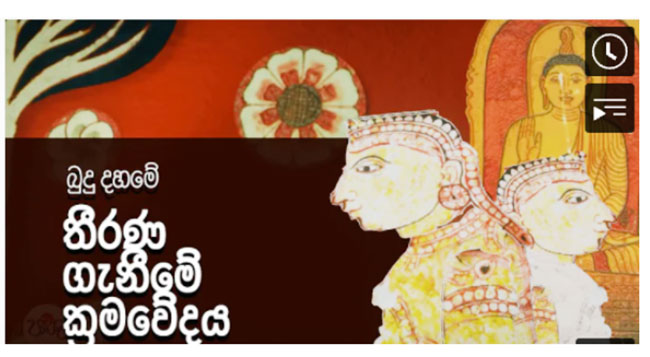Features
A fertile environment for critical thinking

YouTube channel ‘Panshu’ launched by Walpola Rahula Institute
By Raj Gonsalkorale
Social media today has linked millions of people with facts, fiction and outright fake news. It has influenced change of governments, election of Presidents, Royalty being found out and disgraced, scandals of every description doing the rounds faster than lightning, and instant messaging becoming integral to the life of millions. Most do not ascertain the veracity of information that is circulating, which can easily be done in most cases by doing a quick internet search, but simply and irresponsibly, have become fodder for social media giants in the market who have reaped millions of dollars as a consequence.
It is debateable whether instant information dissemination has made the world a better place for human beings and whether their quality of life has improved. Following statistics presents a considerably bleak world.
The world poverty rates (The World Bank says that in 2020, About 9.2% of the world, or 689 million people, lived in extreme poverty on less than $1.90 a day),
Number of refugees (according to the UNHCR’s latest report for 2020, “some 79.5 million people had been forced from their homes due to persecution, conflict, and human rights violations.” That number includes 29.6 million refugees, 4.2 million asylum seekers, as well as 45.7 million internally displaced people (IDPs).
Access to safe drinking water (WHO, in its 2019 report estimated that 2.2 billion people need access to safely managed drinking water, including 884 million currently without basic drinking water services)
Number without basic food requirements (Action Against Hunger sates that about 690 million people globally are undernourished)
Access to basic health services (according to the World Bank and WHO, at least half of the world’s population cannot obtain essential health services, according to a new report published in 2017)
State of the world’s environment (The UN says that “If current trends continue and the world fails to enact solutions that improve current patterns of production and consumption, if we fail to use natural resources sustainably, then the state of the world’s environment will continue to decline. It is essential that we understand the pace of environmental change that is upon us and that we start to work with nature instead of against it to tackle the array of environmental threats that face us) https://www.un.org/sustainabledevelopment/blog/2016/05/rate-of-environmental-damage-increasing-across-planet-but-still-time-to-reverse-worstimpacts/#:~:text=Across%20the%20world%2C%20climate%20change,Sustainable%20Development%2C%20the%20reports%20state.
That is the reality of the world that is interconnected before one can blink an eye lid! As of January 2021 it has been reported that there were 4.66 billion active internet users worldwide – 59.5 percent of the global population. Of this total, 92.6 percent (4.32 billion) accessed the internet via mobile devices. https://www.statista.com/statistics/617136/digitalpopulationworldwide/#:~:text=How%20many%20people%20use%20the,the%20internet%20via%20mobile%20devices. The power of the internet has given enormous mind changing powers to social media giants, but as mentioned at the outset here, it is highly debateable whether this power has been harnessed to improve the quality of life for people and whether instant messaging has, in effect, brought people closer to one another.
A discussion on this topic could very well be both esoteric and fruitless; understood and appreciated by a few, and of not much consequence to many. It is this statement that has relevance to the effort of Venerable Galkande Dhammananda and the Walpola Rahula Institute, to introduce a fundamental tenant of what Buddha had taught more than 2500 years ago.
In the inaugural programme of the rebranded WRI YouTube channel “Panshu”, Ven Dhammananda makes an enthralling presentation based on the Chulla Haththi Padopama Sutta which hopefully will leave viewers contemplating how well an ancient truism has been contextualised to a modern setting for its relevance today.
It is said that of many Suttas diversely found in the Buddhist text, Arahat Mahinda chose Chulla Haththi Padopama Sutta as the first discourse seed to feed Buddhist philosophy into King Devanampiyatissa (http://dailynews.lk/2021/06/24/features/252307/intellectual-discourse-led-new-social-foundation)
It is highly relevant that today, in the age of a world so instantly linked to one another, to relive what the Buddha himself extolled, and later Ven Mahinda presented to the people of Sri Lanka during his visit more than 2000 years ago, and now, what Ven Dhammananda presents to the contemporary world.
The following is adopted from Venerable Dhammananda’s presentation on this inaugural Panshu programme and begins with the question whether Buddhism provides a guide to evaluate a situation before arriving at better decisions after critical inquiry. The answer is: yes, it does.
Quote “Before we introduce the Buddhist model of decision making, let us familiarise ourselves with two general decision-making models that exist in society – the Pilotika model and the Janussoniya model. One day, Pilotika and Janussoniya met on the streets. Hearing from Pilotika that he is returning from an audience with Buddha, Janussoniya inquires whether Buddha is a noble person. Pilotika replies in the affirmative. Janussoniya then questions how Pilotika decided that Buddha is noble. Pilotika’s answer is quite important. He says: I decided that Buddha is noble because I saw expert debaters coming to debate with Buddha, having prepared extensively. However, upon a brief conversation, they gave up their prepared debating points, agreed with Buddha, and even became followers of Buddha. Having seen this, I decided that Buddha is noble. Having heard Pilotika’s answer, Janussoniya gets down from the chariot, asks where Budda stayed and salutes in the direction of Buddha, praising his nobleness.
Many of us make decisions following these two models. Pilotika’s decision of Buddha’s nobleness was not a result of consideration of Buddha’s discourse. It was simply a decision inspired by those Pilotika deemed to be important members of society.
When an actor or actress you like promotes a particular soap to become beautiful, or a sportsperson promotes a specific type of milk to make you stronger, some people believe that to be the utmost truth. This kind of thinking follows the Pilotika model. Janussoniya model involves much less evaluation than even the Pilotika model. People following the Janussoniya model make decisions purely based on someone’s word. They would listen to the news telecast at night or someone’s recital of newspaper headlines in the morning and accepts that with no critical evaluation.
Going back to the original story, after this incidence, Janussoniya meets Buddha and describes his conversation with Pilotika. This is when Buddha rejects both Pilotika and Janussoniya models and describes the proper way of arriving at a conclusion or making critically evaluated decisions – in the form of a story:
A person entering a jungle observes a large footprint of an elephant. Having seen the sheer size of the impression, he decides that the print belongs to the ‘King Elephant’ of the jungle. However, Buddha suggests that he should look for further signs as other elephants can also have large footprints. Then the person observes broken branches, high above in the canopy – suggesting the elephant’s height and the reach of its trunk. However, still, this is not enough proof for a conclusion. There could be other elephants as tall. Then he observes mud streaks on branches higher up, again suggesting strong evidence of a tall elephant. Yet, there could be other tall elephants. Search further.
Next, he observes damages on tree trunks made by elephant tusks. These damages suggest the height, size of the tusks and the strength of the elephant. Although this is even more substantial proof, yet it’s not sufficient proof to draw a final conclusion. Lastly, he sees with his own eyes the ‘King Elephant’ grazing the fields. Having seen with his own eyes, having confirmed what he has seen, only then can he conclude – teaches Buddha.
This model demonstrates to us that you shouldn’t come to a conclusion just by mere sight or mere word. You should collect further proof; you should examine further. Finally, only after coming to a concrete understanding after critical evaluation should you arrive at a final conclusion.
Practically, we may not be able to achieve a concrete understanding of everything in the world. We may need to stop at the footprint stage, broken branches stage, mud streak stage or the tusk damage stage. If we are in one of these stages, then our statements cannot be conclusive. Then it is essential to be aware that our understanding is incomplete” Unquote
Venerable Dhammananda concludes thus “You may now see that, in the ‘Buddha’ model of decision making, there is zero room for blind faith; that critical evaluation is held in high regard. Now, let us reflect. Do you belong to the Pilotika model, Janussoniya model or the Buddha model?”
The lesson for all is the need for nurturing critical thinking and to question information and its veracity. In explaining the thinking behind naming the new YouTube channel as Panshu, Ven Dhammananda said that the philosophy of the WRI has always had a positive outlook and it has focused on what could be done to have better outcomes, even over time, rather than just being disappointed with existing outcomes.
He said that on the one hand, Panshu may be considered as being basically all the elements of soil that graces the Earth’s surface and the final repository of everything that is material irrespective of who one is and their wealth. Ignorance of this fact, and being blinded by perceptions, unable to come to terms with reality and look at life more objectively, critically and with unconditional love to others, have left many disappointed and dissatisfied with what they currently have around them.
On the other hand, one could look at Panshu or soil, as being a fertile environment to grow new thinking, new ideas, and an avenue for renewal of ethical and moral values, so that outcomes, even if it takes time for fruition, will yield a more loving, compassionate, ethical and moral world. Ven Dhammananda said the WRI, through Panshu, will be providing opportunities for experiencing, questioning, and discussing and engaging in critical thinking through a variety of programs that are being designed as a pathway for a better future. “We yield what we sow, so, it is important to sow correct thinking so that we can yield a better future without just complaining about the present” he said.
The first program on Panshu may be accessed via https://www.youtube.com/watch?v=x9zc7JpA3cs
Features
‘Silent Majority’ abandoned to Long-suffering in regional conflicts

 With reports emerging that India has attacked some ‘sites’ in Pakistan and Pakistan-administered Kashmir, the question could be posed whether the stage has just been set for yet another costly India-Pakistan military conflict. Sensible opinion in South Asia could only hope that wise counsel would sooner rather than later come to prevail on both sides of the divide and that they would draw back from the brink of full-scale war.
With reports emerging that India has attacked some ‘sites’ in Pakistan and Pakistan-administered Kashmir, the question could be posed whether the stage has just been set for yet another costly India-Pakistan military conflict. Sensible opinion in South Asia could only hope that wise counsel would sooner rather than later come to prevail on both sides of the divide and that they would draw back from the brink of full-scale war.
The states concerned ought to know fully well the possible wide-ranging weighty consequences of another regional conflict. It should be plain to see that it would benefit none in the two theatres of confrontation, most particularly the relevant publics or the ‘Silent Majority’.
In fact, in connection with the mentioned initial military attacks, the Pakistani side has gone on record that some civilian lives have been lost. Such losses could burgeon in the event of full scale hostilities. These costs could of course be staggering and unimaginable in the event the nuclear option is resorted to by the sides, going forward.
Accordingly, the hope of the peace-loving world-wide is likely to be that India and Pakistan would give negotiations a chance and resolve their differences peacefully. It would be in the best interests of the world for the champions of peace to join their voices to that of UN chief Antonio Guterres and call on the sides to negotiate an end to their differences.
The utter helplessness and misery of the people of the Gaza ought to drive home afresh the horrors of war. Currently the news is that the Gazans are literally starving to death. Food and other essentials provided by UN agencies are reportedly being prevented by Israel from getting to the hapless people of Gaza. So dire is their situation that concerned quarters are calling on the compassionate worldwide to provide the Gazans with food, water and other essentials voluntarily. This SOS would need to be heeded forthwith.
Accordingly, it could be inferred that most formal arrangements, including those that are generally under the purview of the UN, geared to providing emergency humanitarian assistance to the needy, have, for all intents and purposes, been rendered ineffective in the Gaza. The UN cannot be faulted for this state of things; rather, Israel should be held accountable in the main for it.
The matter of accountability is central to the dramatic slide into lawlessness the world has been experiencing over the past few decades. As could be seen, International Law is no longer fully applicable in the conflict and war zones of the world because it is not being adhered to by many state and non-state aggressors. That the UN is hapless in the face of such lawlessness is plain to see.
We have of course the Middle East wherein International Law has fallen silent for quite a while. How could it be otherwise, when Israeli aggressions are being winked at by the US, for which the policy of backing Israel is almost sacrosanct?
Moreover, under President Donald Trump, it is difficult to see the US changing policy course on the Middle East. Trump made vague promises of bringing peace to the region in the run-up to his reelection but has done nothing concrete by way of peace-making. Consequently, complete lawlessness prevails in the Middle East. US policy towards Israel counts as another example of how the self- interest of US central administrations blinds them to their international obligations, in this case Middle East peace.
However, the commentator could be criticized as being biased if he holds only Israel responsible for what has befallen the Middle East. It has been the position of this columnist that Israel’s security needs should be taken cognizance of by its state and non-state adversaries in the Middle East and acted upon if the basis is to be laid for a durable Middle East peace. Inasmuch as Palestinian statehood must be guaranteed, the same should be seen as applicable to Israel. The latter too enjoys the right to live in a secure state of its own, unopposed by its neighbours.
The Ukraine of today is also sad testimony to the ill consequences of powerful, aggressor states wantonly disregarding International Law and its obligations. Nothing could justify Russia in invading Ukraine and subjecting it to a condition of Longsuffering. Clearly, Ukraine’s sovereignty has been violated and such excesses go to the heart of the current state of ‘International Disorder’. Of course the same stricture applies to the US in relation to its military misadventures in Afghanistan and Iraq, to name just two such modern examples.
There is no ducking the fact, then, that civilian publics in the mentioned theatres of war and outside, are being subjected to the worst suffering as a consequence of the big powers’ self-aggrandizement schemes and military misadventures. Longsuffering becomes the tragic lot of the people who have nothing to do with such unbridled power ambitions.
One would not be exaggerating the case if he states that civilian publics count for almost nothing in the present ‘International Disorder’. Increasingly it is becoming evident that from the viewpoint of the big powers and authoritarian governments the people are of little or no importance. Considering that self-aggrandizement is of the paramount interest for the former the public interest is coming to be seen as inconsequential.
Consequently, not much of a case could be made currently for the once almost reverentially spoken of ‘Social Contract’. For, the public interest does not count for much in the scrambles for power among the major powers who are seen at the popular level as the principal history-makers.
It is in view of the above that much is expected of India. Today the latter is a ‘Swing State’ of the first importance. Besides being a major democracy, it is one of the world’s principal economic and military powers. It possesses abundant potential to help to put things right in international politics. If there is one state in Asia that could help in restoring respect for International Law, it is India.
Considering the above, India, one believes, is obliged to bear the responsibility of keeping South Asia free of any more long-running, wasting wars that could aggravate the material hardships and socio-economic blights of the region. Thus, India would need to consider it imperative to negotiating peace with Pakistan.
Features
Memorable happening … Down Under

 Under the Global-Ise Australia Advanced Sports Development Programme, a delegation of 15 swimmers from Lyceum International School, Wattala, had the remarkable opportunity to train and experience high-performance sports development in Melbourne, Australia.
Under the Global-Ise Australia Advanced Sports Development Programme, a delegation of 15 swimmers from Lyceum International School, Wattala, had the remarkable opportunity to train and experience high-performance sports development in Melbourne, Australia.
The 10-day programme was carefully curated to offer intensive training, educational exposure, and cultural experiences for the young athletes.
The swimmers underwent specialised training through Swimming Victoria’s elite programme, held at some of Melbourne’s premier aquatic facilities.

Visit to Victorian Parliament
Each day began as early as 5:00 a.m. and continued until 7:00 p.m., ensuring a rigorous and enriching schedule that mirrored the standards of international competitive swimming.
Beyond training, the programme offered a wide array of experiences to broaden the students’ horizons.

Morning training
The tour group explored iconic landmarks such as the Victorian Parliament and the Melbourne Cricket Ground (MCG), and enjoyed shopping at Chadstone – The Fashion Capital. They also experienced the natural beauty of Victoria with visits to Yarra Valley Chocolaterie & Ice Creamery, and Cardinia Reservoir Park, where they observed kangaroos in their natural habitat.
An academic highlight of the tour was the group’s exclusive visits to three of Australia’s leading universities: the University of Melbourne, Monash University, and Deakin University. These visits aimed to inspire students and showcase the vast educational opportunities available in Australia.

Checking out the scene at Yarra Valley Chocolaterie & Ice Creamery
As part of the cultural immersion, Global-Ise hosted a traditional Australian BBQ at the Tim Neville Arboretum in Ferntree Gully. The students also enjoyed a variety of diverse culinary experiences each evening, further enriching their understanding of local and international food cultures.
The tour concluded with a celebratory dinner at the Spicy Wicket Restaurant, where each participant received a presentation in recognition of their involvement.

Enjoying an Aussie BBQ for lunch
The evening was made especially memorable by the presence of Pradeepa Saram, Consul General of Sri Lanka in Victoria.
Global-Ise Management—Ken Jacobs, Johann Jayasinha, and Dr Luckmika Perera (Consultant from the University of Melbourne)—did a magnificent job in planning and the execution of the advanced sports programme.

Coaches from Sri Lanka presenting a plaque to Global-Ise Management team
Ken Jacobs (centre), Johann Jayasinha, and Dr Luckmika Perera (on the right
Features
Bright, Smooth Skin

 Hi! How’s the beauty scene keeping with you?
Hi! How’s the beauty scene keeping with you?
Phew, this heat is awful but there is nothing that we can do about it.
However, there are ways and means to take care of your skin and I will do my best to help you in every way I can.
Well, this week, let’s go for a Bright, Smooth Skin.
Gram flour (also known as besan) is a traditional skincare ingredient known for its:
* Natural exfoliating properties.
* Ability to absorb excess oil.
* Gentle brightening and tan-removal effects.
* Suitability for all skin types, especially oily and acne-prone skin.
You will need 01–02 tablespoons gram flour (besan) and rose water, or raw milk, to make a paste.
You could add the following two as optional add-ins: A pinch of turmeric (for extra glow), and a few drops of lemon juice (for oily skin and pigmentation)
Add the gram flour to a small bowl and mix in the rose water (for oily/sensitive skin) or raw milk (for dry skin) slowly.
Stir well to make a smooth, spreadable paste—not too thick, not too runny.
Now apply this mixture, evenly, to your damp face and neck, and let it sit for 5–10 minutes (don’t let it dry completely if you have dry skin).
Gently massage in circular motions using wet fingers—this helps exfoliate.
Rinse off with lukewarm water, and then pat your skin dry.
Use it 02–03 times a week for best results.
Skin Benefits:
* Removes dirt, sweat, and oil without stripping natural moisture.
* Gently exfoliates dead skin cells, revealing smoother skin.
* Brightens the complexion and fades mild tanning.
* Helps clear clogged pores and reduce pimples.
* Leaves skin fresh and glowing—perfect for humid climates.
-

 News7 days ago
News7 days agoRanil’s Chief Security Officer transferred to KKS
-

 Opinion5 days ago
Opinion5 days agoRemembering Dr. Samuel Mathew: A Heart that Healed Countless Lives
-

 Business3 days ago
Business3 days agoAitken Spence Travels continues its leadership as the only Travelife-Certified DMC in Sri Lanka
-

 Business3 days ago
Business3 days agoLinearSix and InsureMO® expand partnership
-

 Latest News2 days ago
Latest News2 days agoNPP win Maharagama Urban Council
-

 Business7 days ago
Business7 days agoCCPI in April 2025 signals a further easing of deflationary conditions
-

 Features5 days ago
Features5 days agoTrump’s economic missiles are boomeranging
-

 Features7 days ago
Features7 days agoExpensive to die; worship fervour eclipses piety












